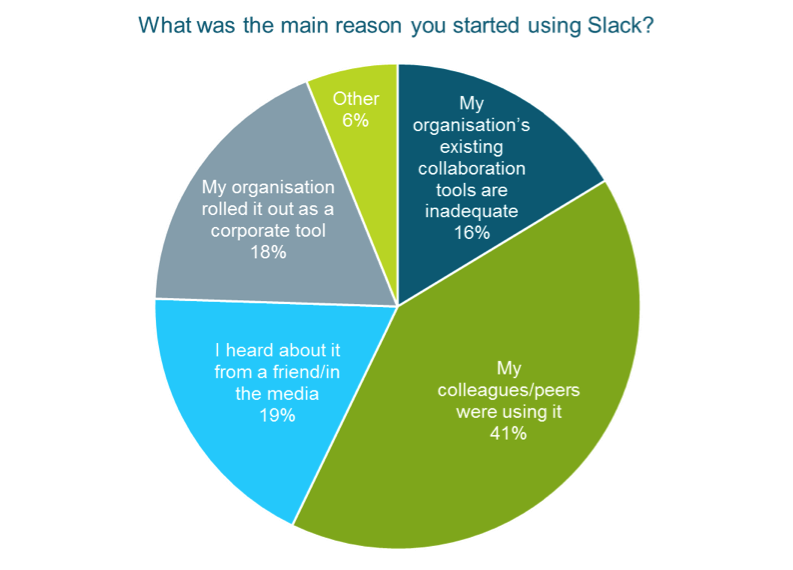Slack: a communications lifeline for small teams
|
|
Amidst the hype surrounding the rapid growth of real-time collaboration start-up Slack, we carried out an online survey to peek beneath the covers of Slack’s sudden popularity. What attracts people to use Slack when there are so many other collaboration technologies already available to businesses, and what are they using it for?
Top takeaways
Slack is currently used by small, internal teams, mostly within small organisations
Our research indicates that Slack is being used predominantly at a grass-roots level within organisations, helping teams to communicate more effectively within the context of particular projects, and is most popular within organisations with fewer than 100 employees. Its growth is underpinned by viral, peer-driven adoption, and most Slack instances are initiated and operated without the formal approval or recognition of management.
Slack fills a gap left by existing business collaboration technologies, and its ease of use is central to adoption
To a large extent, the current market for business communication and collaboration tools is most heavily focused on large enterprises; there is little support for smaller, more nimble organisations. This is an opportunity that Slack currently addresses well, through a simple user experience which is easy for new users to embrace. However, some respondents in our survey expressed concerns about Slack as a long-term solution to their problems; clearly there is still room for improvement – the question is whether Slack can maintain its head start in this space while meeting the increasingly educated needs of users.
What’s behind the Slack hype?
Since its ‘preview’ beta release in August 2013, real-time business communications tool Slack has gained profile and adoption at an impressive rate, achieving 2.3 million users by February 2016 – the second anniversary of its official launch. Of these, 675,000 are paid users, and the company is projecting annual recurring revenues of $64 million for this year.
Though it is a business rather than consumer tool, Slack has attracted attention for the fanbase the product has gained in such a short timeframe, with enthusiasts vocally advocating its benefits and their love for the product. The technology is also prompting a reaction from established players in the enterprise collaboration software space, with Jive Software introducing its Jive Chime mobile messaging product and IBM launching Project Toscana in response to this emerging opportunity.
To dig a little deeper into the truth behind the hype – beyond the marketing and the software industry’s tendency to view the latest fad as a dead cert – we decided to carry out a small survey of our own to understand what is prompting Slack adopters to start using the tool, and what they are getting out of it. Our online survey was carried out over three weeks in February and March 2016, inviting users of Slack to share their views and experiences. 49 people participated on a self-selection basis, with the vast majority (62%) coming from the Technology sector. The demographics of the survey group are shown in the Appendix section at the end of this report.
Peer-driven, viral adoption is propelling growth of Slack
Our research confirms that use of Slack within organisations is predominantly virally-driven, with adoption growing through ‘grass roots’, peer recommendations rather than through company-led initiatives.
Of our survey group, only 18% began using Slack because their organisation had selected the product as a corporate tool; the remainder either took the initiative themselves to try it, or were encouraged by colleagues or peers within the organisation who were already using Slack. Of those organisations where there was a corporate decision to deploy Slack, these were almost exclusively small organisations with fewer than 500 employees. Interestingly, peer-driven adoption seems to be particularly strong among organisations with between 20 and 100 employees, accounting for more than half of the respondents for this answer.

Source: MWD Advisors
Slack is primarily used within departmental teams
Slack is positioned as a team communications tool, so it is perhaps not surprising to discover that the majority of our survey participants are using it to work with their immediate teams; 65% responded that they do this “a lot”, while more than 90% use it for this purpose at least some of the time (see below). However, Slack is not playing as significant a role in connecting people in different parts of organisations, with only 29% using it extensively for cross-organisation collaboration – and managers are also being left out of the conversation, with only 16% communicating with more senior staff via Slack on a regular basis.
>>> There’s more to this report, but you don’t currently have a subscription to read it.
Do you already have membership (like 6,000+ others)? If so, make sure you’re logged in.
To read our FREE reports, all you have to do is sign up for a free membership.
PREMIUM reports are reserved for Premium members: you can subscribe as an individual for just GBP 59.00 / month, or get access through a Corporate subscription.
The post Slack: a communications lifeline for small teams appeared first on The Advisor.
Leave a Comment
You must be logged in to post a comment.







